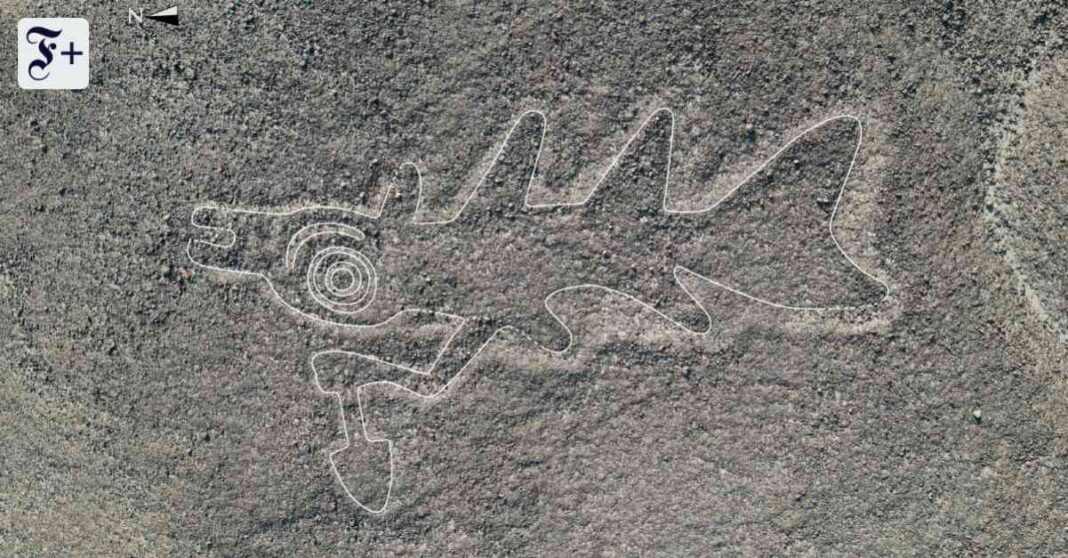In the vast desert of Peru lies a hidden archaeological treasure that has been sleeping for two millennia, waiting to be discovered by the world. The Nazca Lines, a series of gigantic geoglyphs etched into the desert floor, have fascinated researchers and historians for centuries. These mysterious symbols were first documented by travelers in the 16th century, who believed them to be ancient road markers.
The Nazca Lines are a collection of hundreds of intricate designs, including animals, plants, and geometric shapes, spread across a 500-square-kilometer area in the Nazca Desert. These massive drawings were created by removing the reddish-brown iron oxide-coated pebbles that cover the surface of the desert floor, exposing the lighter-colored earth beneath. The contrast between the two colors creates the striking images that can only be fully appreciated from above.
Despite their impressive size and complexity, the purpose of the Nazca Lines remains a mystery. Some researchers believe that they served as an ancient astronomical calendar, while others suggest that they were used in religious ceremonies or as markers for water sources. The truth may never be known for certain, but advancements in technology are bringing us closer to unlocking the secrets of this ancient civilization.
Uncovering the Nazca Lines with Artificial Intelligence
One of the most exciting developments in the study of the Nazca Lines is the use of Artificial Intelligence (AI) to analyze and interpret these enigmatic symbols. By harnessing the power of machine learning algorithms, researchers are able to process vast amounts of data and identify patterns that may have eluded human researchers. This cutting-edge technology is revolutionizing the field of archaeology and offering new insights into the ancient civilizations that created these remarkable artworks.
AI has the potential to significantly accelerate the discovery and interpretation of the Nazca Lines by automating the process of analyzing the vast amount of data collected from aerial surveys and ground-based research. By identifying correlations between different geoglyphs and patterns, AI can help researchers piece together the puzzle of the Nazca Lines and shed light on their purpose and significance.
The Significance of the Nazca Lines
The Nazca Lines are not just a curiosity or a tourist attraction – they are a window into the past, offering valuable insights into the beliefs, practices, and technology of the ancient Nazca civilization. These intricate designs were painstakingly created by a people who had a deep connection to the land and a sophisticated understanding of geometry and astronomy.
By studying the Nazca Lines, researchers can gain a better understanding of how the ancient Nazca people lived, how they interacted with their environment, and what beliefs and values they held. These geoglyphs are a testament to the creativity and ingenuity of a civilization that flourished in the desert thousands of years ago, leaving behind a legacy that continues to captivate and inspire us today.
Preserving the Nazca Lines for Future Generations
As interest in the Nazca Lines grows and more researchers flock to the desert to study these ancient symbols, the need for conservation and protection becomes increasingly urgent. The fragile desert environment is vulnerable to erosion, vandalism, and climate change, putting the Nazca Lines at risk of being damaged or destroyed.
Efforts are underway to safeguard the Nazca Lines for future generations by implementing conservation measures, limiting access to the sites, and raising awareness about the importance of preserving these cultural treasures. By working together to protect and respect the Nazca Lines, we can ensure that they remain intact for centuries to come, allowing future generations to marvel at the ingenuity and artistry of the ancient Nazca civilization.
In conclusion, the Nazca Lines are a testament to the creativity and ingenuity of the ancient Nazca civilization, offering valuable insights into their beliefs, practices, and technology. With the help of Artificial Intelligence, researchers are making significant strides in uncovering the mysteries of these enigmatic symbols, bringing us closer to understanding the purpose and significance of these remarkable artworks. It is essential that we work together to preserve and protect the Nazca Lines for future generations, ensuring that this ancient treasure continues to inspire and captivate us for years to come.















